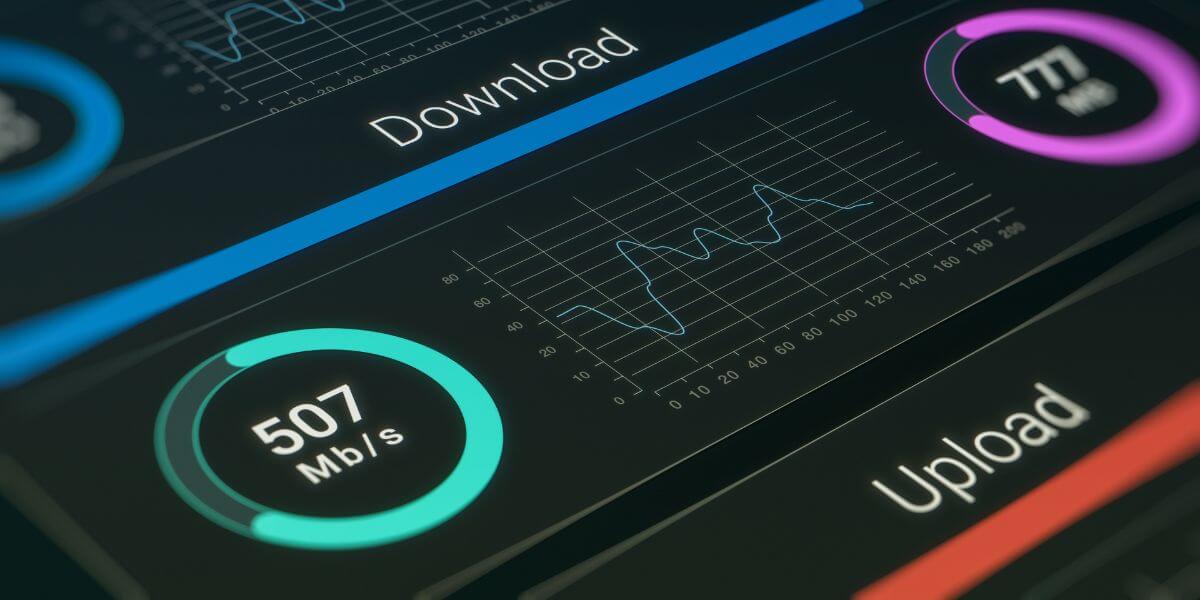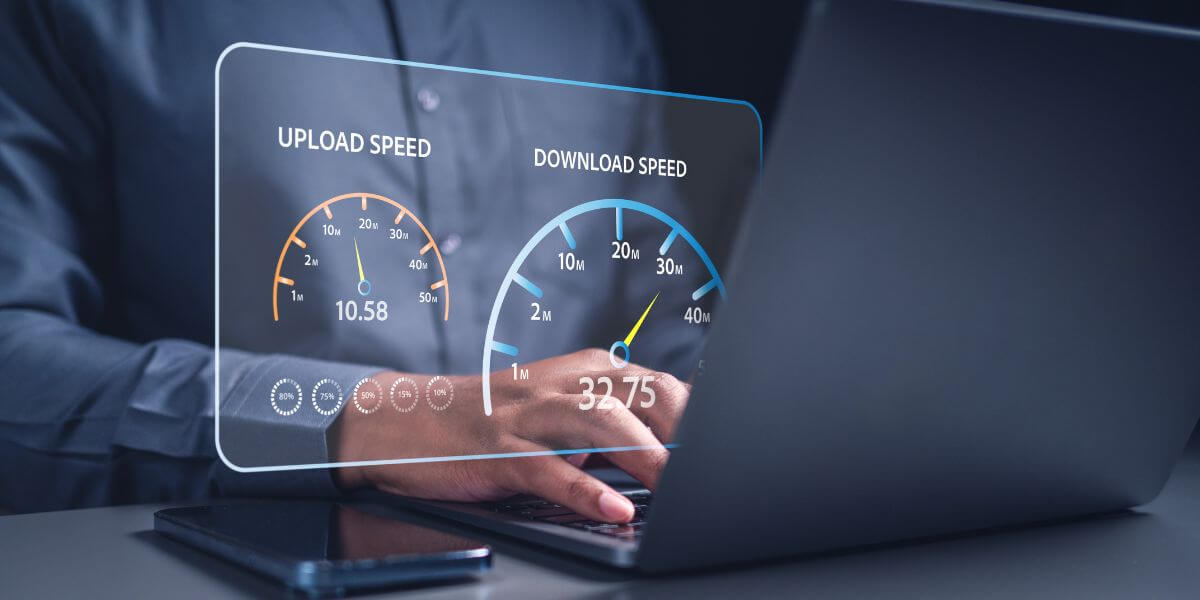How to Test Your Fiber Speeds and What Results to Expect
Table of Contents
Knowing how to test your fiber internet connection the right way is key to making sure you’re actually getting the speeds you’re paying for. Whether you’re streaming 4K content, working from home, or gaming online, accurate speed testing helps you verify your connection performance and troubleshoot any issues that might arise.
Why Testing Fiber Speed Matters
Fiber internet is the gold standard for home connectivity, offering speeds that far exceed traditional cable or DSL connections. However, various factors can impact your actual speeds, making regular testing crucial for maintaining optimal performance. When you’re testing fiber speed, you’re not just checking a number, you’re ensuring your investment in premium internet service is delivering the promised results.
Many customers wonder if they truly have the best internet in their area, and speed testing provides concrete data to answer that question. Unlike other connection types that can fluctuate dramatically based on network congestion or distance from service points, fiber connections should deliver consistent, reliable speeds that closely match your subscribed plan.
Understanding Your Fiber Speed Test Results

Download vs. upload speeds
When you run a speed test, you’ll see two primary measurements: download speed and upload speed. Download speed is how quickly data flows from the internet to your device, affecting activities like streaming, browsing, and downloading files. Upload speed measures data flowing from your device to the internet, impacting video calls, cloud backups, and file sharing.
Fiber internet’s symmetrical speeds mean your upload and download speeds should be nearly identical, unlike cable internet where upload speeds are typically much slower. This symmetry makes fiber particularly valuable for households with multiple users or businesses requiring robust two-way data transfer.
Speed measurements appear in either megabits per second (Mbps) or gigabits per second (Gbps) [1]. A megabit contains one million bits of data, while a gigabit contains one billion bits. To put this in perspective, 1 Gbps equals 1,000 Mbps, representing dramatically faster speeds than most traditional internet connections can achieve.
How to Test Your Fiber Connection Accurately
The most reliable method for testing fiber speed involves using your internet service provider’s official testing tools. For Fidium customers, the Attune™ or Attune@Work™ WiFi app provides the most accurate measurements, offering both device-specific WiFi testing and direct gateway testing capabilities.
Device Speed Testing via WiFi
Device speed testing measures the WiFi performance from your specific connected device to the speed test server. While convenient, this method may not reflect the actual speed your provider delivers to your home due to various factors including WiFi interference, device capabilities, and network congestion.
To perform a device speed test, simply tap the Your Device icon from the app’s main screen, then select Device Speed Test. The test runs automatically, providing results within moments. If the test fails, wait briefly and tap Retry to attempt the measurement again.
Direct Internet Connection Testing
Direct internet connection testing provides a more accurate representation of your actual fiber speeds by measuring the connection directly from your gateway to the speed test server. This method bypasses potential WiFi-related limitations and interference.
Access this feature by clicking the WiFi gateway icon in your Attune app’s center, which displays your ISP Speed Test history. Tap “Check Speed Now" to initiate a new test. You can disable automatic speed testing using the toggle switch if you prefer manual control over when tests occur.
Optimizing Your Speed Test Accuracy

Making the most from your speed test
Several factors influence speed test accuracy, and understanding these variables helps ensure reliable results. Even with gigabit fiber service, real-world conditions are rarely perfect, so it’s normal to see some variation from the theoretical maximum speeds.
For the most accurate results when testing fiber speed, use a wired Ethernet connection rather than WiFi whenever possible. Connect your device directly to your Fidium-provided gateway using Cat 5 or Cat 6 Ethernet cables, as these cables support the high-speed data transfer that fiber connections provide.
WiFi testing inherently introduces variables that can reduce apparent speeds, including interference from other devices, distance from the router, and physical obstacles. Speed test results over WiFi will vary significantly between different device types, with newer devices generally achieving better performance than older models.
If your laptop lacks an Ethernet port, invest in a quality adapter. Thunderbolt and USB 3.0 adapters typically perform best, though any adapter will consume some bandwidth for administrative overhead, usually 5 to 10 percent of total available bandwidth.
Device and Equipment Considerations
Your speed test results are limited by the slowest component in your testing chain. Older laptops may only process speeds up to 100 Mbps, regardless of your fiber plan’s capabilities. To test multi-gigabit speeds, you need devices with corresponding capabilities and sufficient processing power.
For optimal 2 Gig testing, use computers built in 2019 or newer with Intel i5 processors (or equivalent), at least 16GB of RAM, and current operating systems like Windows 10 or macOS 10 or higher. These specifications ensure your device can handle the data processing requirements of ultra-high-speed testing.
Browser selection also impacts results. Use current versions of Google Chrome, Mozilla Firefox, Safari, or Microsoft Edge, and disable all browser plugins during testing. Internet Explorer is not supported for accurate speed testing. Additionally, disconnect from VPN services and disable wireless adapters when testing via Ethernet.
Expected Speed Ranges for Different Plans
Knowing what speeds to expect helps you figure out if your connection is living up to its promises. While the perfect speeds advertised are usually only seen in ideal conditions, your actual speeds should come pretty close to what’s advertised in your plan.
Fidium’s fiber plans deliver speeds that typically range from 90 to 100 percent of advertised rates under optimal conditions. However, various factors can impact these results, including network traffic, device limitations, and testing methods. Multi-gigabit plans like 2 Gig service require newer equipment to achieve maximum speeds, but the ultra-fast connection reaches your gateway regardless of individual device capabilities.
When to Compare Internet Providers
If your speed tests consistently show results significantly below your plan’s advertised speeds, it might be time to compare internet providers and evaluate your options. Many customers research whether they have the best internet providers in their area when experiencing performance issues.
When conducting an internet comparison, consider not just advertised speeds but also consistency, customer service quality, and pricing transparency. Compare internet plans based on actual user experiences rather than marketing claims alone. Fiber providers typically offer more reliable speeds than cable or DSL alternatives, but significant variations exist between companies.
Internet prices vary considerably between providers and technologies, with fiber often coming with better long-term value despite potentially higher upfront costs. When you compare internet providers, factor in equipment fees, installation costs, and promotional pricing that may increase after introductory periods.
Troubleshooting Below-Expected Speeds
If your speed tests reveal performance below expectations, several troubleshooting steps can help identify and resolve issues. First, make sure you’re testing during off-peak hours when network congestion is minimal. Peak usage periods in evenings and weekends can impact results even on fiber connections [2].
Disable all other network devices during testing to eliminate competition for bandwidth. Streaming services, cloud backups, and automatic updates can consume significant bandwidth, skewing test results. Close unnecessary applications and pause any downloads or uploads before testing.
Check all cable connections and ensure you’re using appropriate Ethernet cables for your speed tier. Damaged or inadequate cables can create bottlenecks that prevent achieving maximum speeds.
Maintaining Optimal Performance

Make sure you’re getting what you’re paying for
Regular speed testing helps maintain optimal fiber performance over time. The Attune app tracks your speed test history, allowing you to identify trends and potential issues before they become serious problems. Fidium monitors these results proactively and can notify you when network adjustments might improve performance.
Keep your equipment updated with the latest firmware and software patches. While Fidium-provided gateways receive automatic updates, customer-owned equipment requires manual maintenance to ensure optimal performance.
Getting Support When Needed
If troubleshooting doesn’t resolve speed issues, contact Fidium support for additional assistance. Persistent speed problems might indicate equipment issues, line problems, or configuration needs that require professional attention.
Professional technicians can perform more advanced diagnostics and determine whether issues stem from your internal network, the fiber connection itself, or external factors affecting service delivery.
Ready to experience the fastest, most reliable internet connection available? Enter your zip code to check Fidium Fiber availability in your area and discover plans that deliver consistent, lightning-fast speeds for all your online activities.
Sources
[1] TechTarget. “megabits per second (Mbps)."
[2] Reddit. “Global Internet Usage Based on Time of Day."
